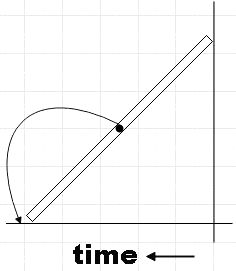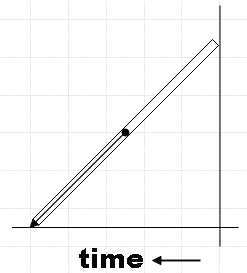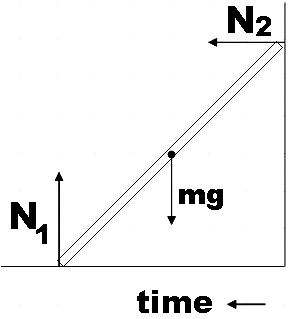
A ladder is leaned against a smooth wall and allowed to slip on a frictionless floor. Which figure represents the trace of its COM?
A.

B.

C.

D.





Answer
556.2k+ views
Hint: As a first step, you could depict the situation in a diagram with all the forces acting on the ladder marked. Now you could locate the COM on the ladder. Now try to imagine the ladder slipping due to the absence of friction from both floor and wall and thus find the probable path traced by this point on slipping.
Complete answer:
In the question, we are given a ladder that is allowed to slip over a smooth surface. We are asked to find the trace made by the centre of mass of the ladder as it falls.
Firstly, let us understand the given system well. For that let us depict the given situation in a diagram by marking all the forces acting on the ladder.

So we see that there are a total of three forces acting on the ladder. They are: normal force ${{N}_{1}}$ from the floor, normal force ${{N}_{2}}$ from the wall and the weight of the ladder in acting vertically downward from the centre of mass.
As the ladder is slipping, the centre of mass doesn’t change position but remains in the same point on the ladder. However, as the ladder is slipping downward the centre of mass also moves downward along with it and at the end is also moved in the left direction, as a result of which it traces a curved path in the downward direction to the left exactly as shown in option A.

Hence, we found that option A correctly represents the path traced by the centre of mass.
Note:
In the question, we are clearly given that the floor is frictionless and the wall is smooth and thus it is quite obvious that the ladder kept touching these surfaces will slip. Also, you could actually imagine the situation happening for real thus get a better understanding. Also, the COM traces this path by remaining exactly at the geometric centre of the ladder during slipping.
Complete answer:
In the question, we are given a ladder that is allowed to slip over a smooth surface. We are asked to find the trace made by the centre of mass of the ladder as it falls.
Firstly, let us understand the given system well. For that let us depict the given situation in a diagram by marking all the forces acting on the ladder.

So we see that there are a total of three forces acting on the ladder. They are: normal force ${{N}_{1}}$ from the floor, normal force ${{N}_{2}}$ from the wall and the weight of the ladder in acting vertically downward from the centre of mass.
As the ladder is slipping, the centre of mass doesn’t change position but remains in the same point on the ladder. However, as the ladder is slipping downward the centre of mass also moves downward along with it and at the end is also moved in the left direction, as a result of which it traces a curved path in the downward direction to the left exactly as shown in option A.

Hence, we found that option A correctly represents the path traced by the centre of mass.
Note:
In the question, we are clearly given that the floor is frictionless and the wall is smooth and thus it is quite obvious that the ladder kept touching these surfaces will slip. Also, you could actually imagine the situation happening for real thus get a better understanding. Also, the COM traces this path by remaining exactly at the geometric centre of the ladder during slipping.
Recently Updated Pages
Master Class 11 Economics: Engaging Questions & Answers for Success

Master Class 11 English: Engaging Questions & Answers for Success

Master Class 11 Social Science: Engaging Questions & Answers for Success

Master Class 11 Biology: Engaging Questions & Answers for Success

Class 11 Question and Answer - Your Ultimate Solutions Guide

Master Class 11 Business Studies: Engaging Questions & Answers for Success

Trending doubts
What is meant by exothermic and endothermic reactions class 11 chemistry CBSE

10 examples of friction in our daily life

One Metric ton is equal to kg A 10000 B 1000 C 100 class 11 physics CBSE

Difference Between Prokaryotic Cells and Eukaryotic Cells

What are Quantum numbers Explain the quantum number class 11 chemistry CBSE

1 Quintal is equal to a 110 kg b 10 kg c 100kg d 1000 class 11 physics CBSE




